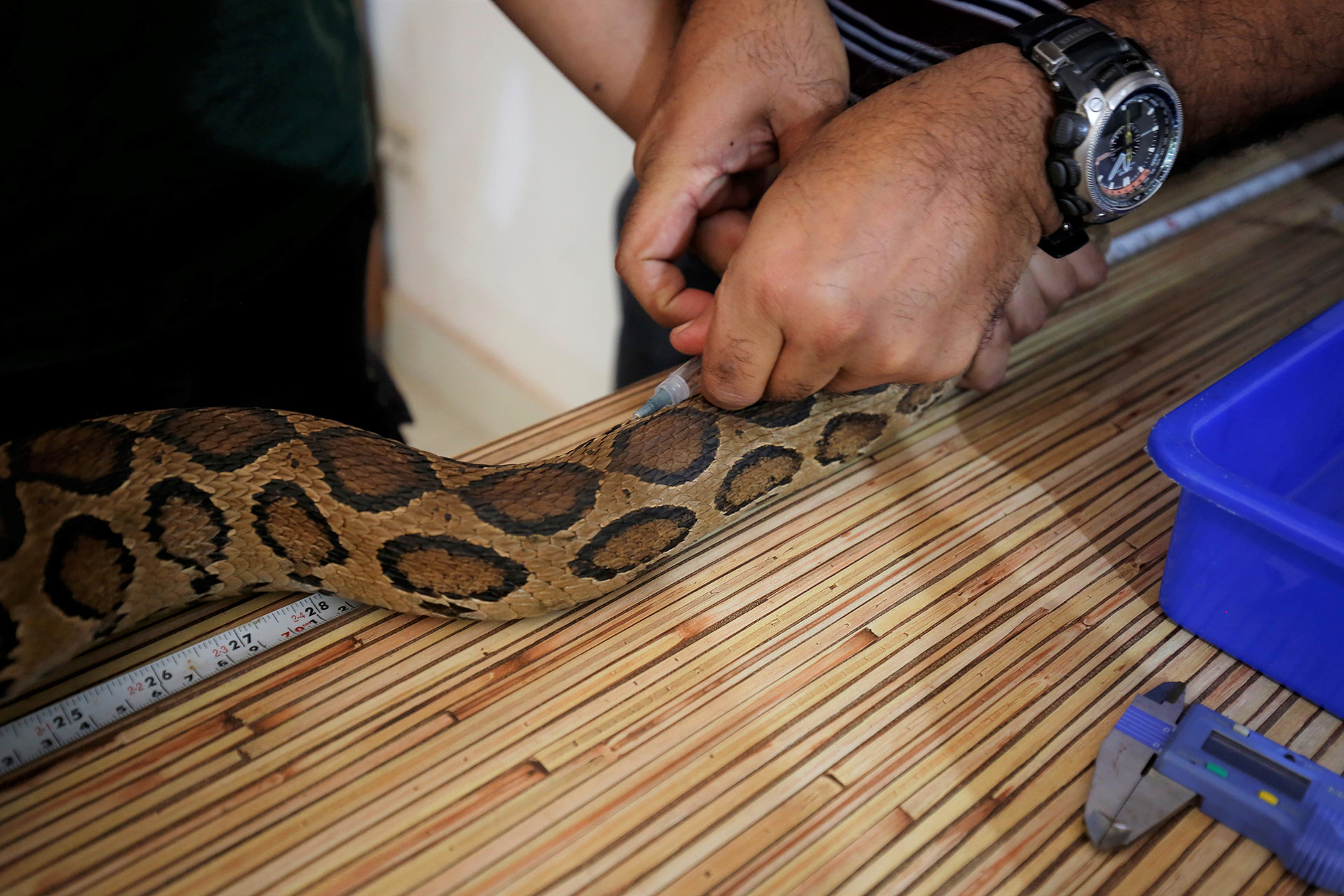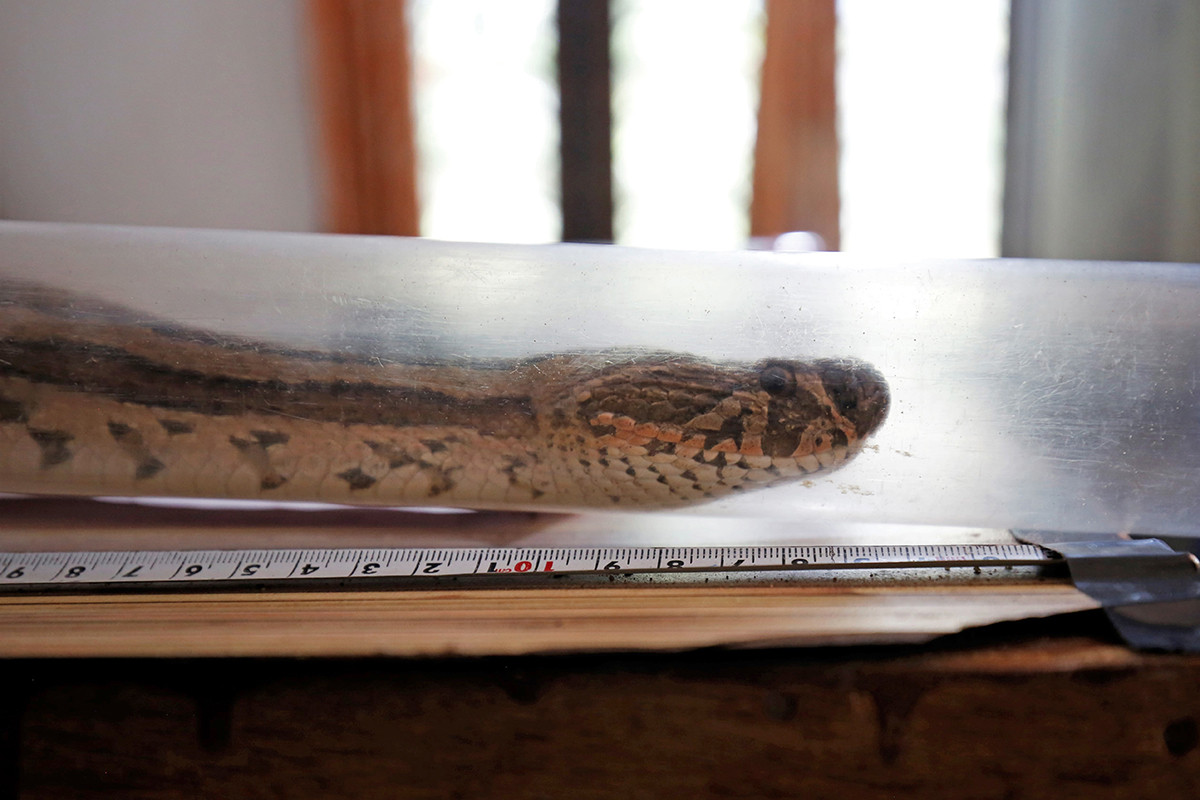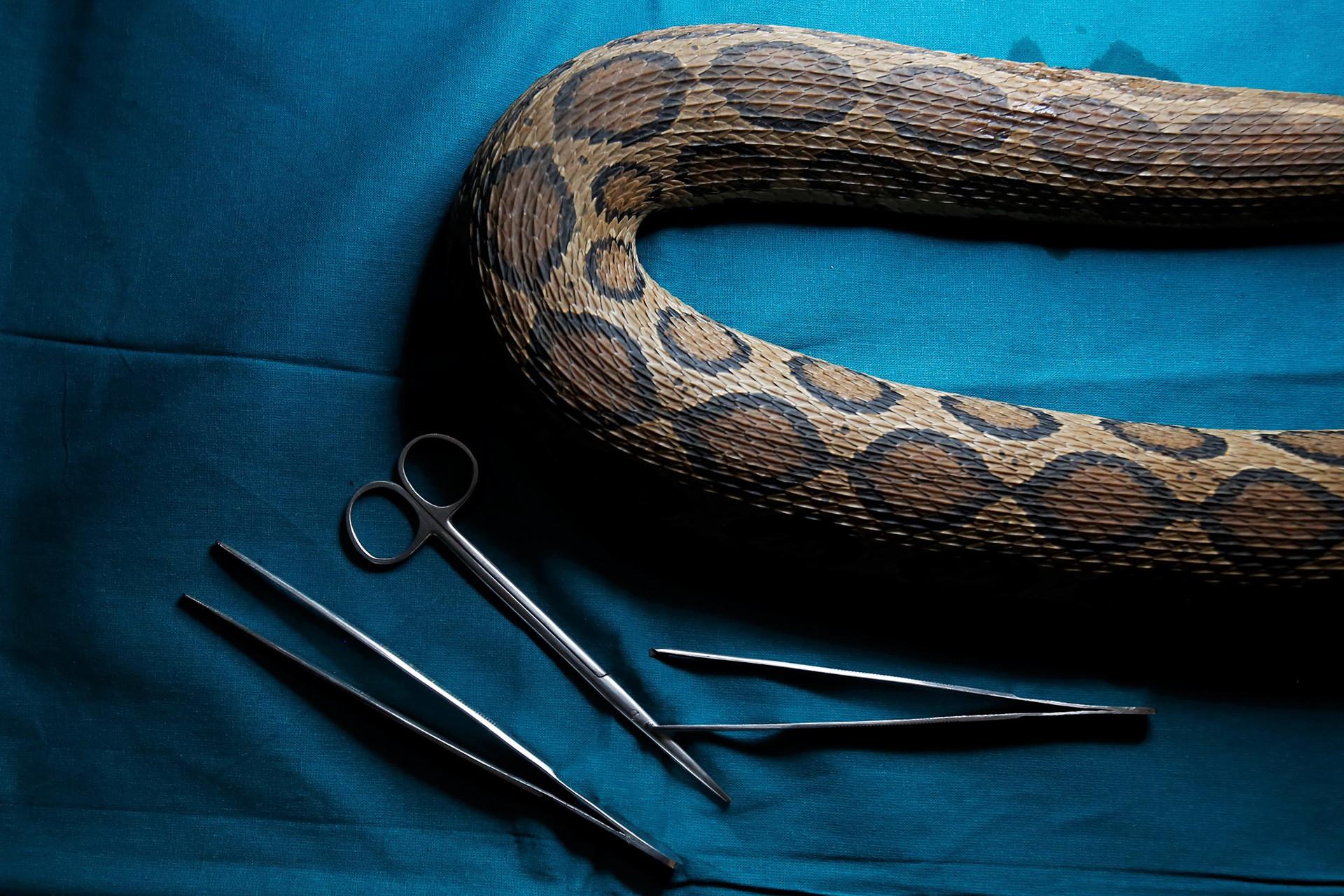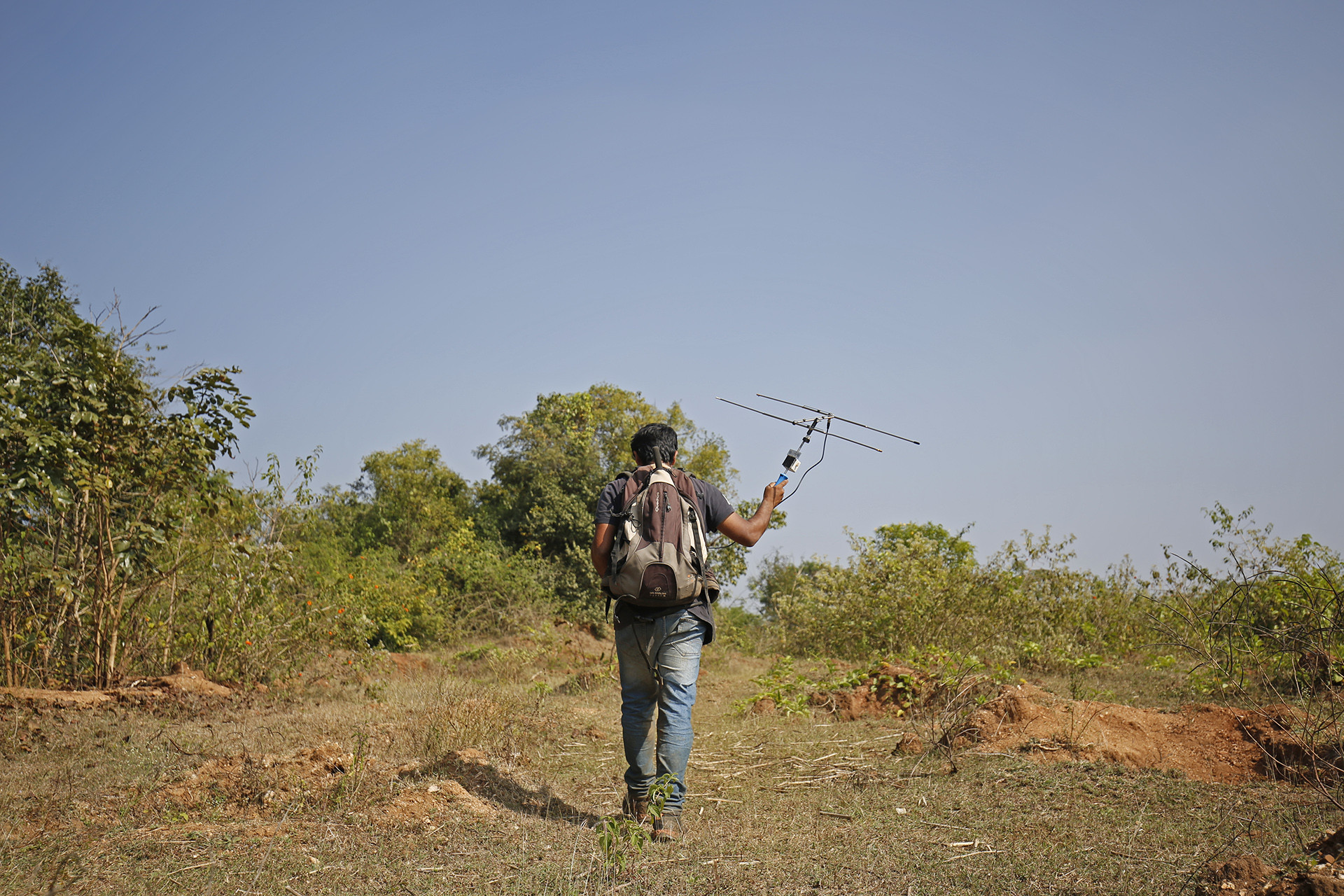- Experts believe that understanding the snake and its behaviour is the first step towards reducing negative human-snake interactions.
- Radio telemetry enables researchers to study a number of factors about snakes that cannot be studied through traditional observations.
- Radio telemetry that uses radio signals from a transmitter inserted in the animal to determine the location of the animal and track it, is emerging as an easier and more precise way to study the natural history, behaviour, and ecology, among other things, of elusive animals like snakes.
In the Malnad region of Karnataka that covers the western and the eastern slopes of the Western Ghats, the King Cobra is nothing short of a deity. Hooded cobras appear as Gods’ allies and divine beings in traditional Hindu texts granting them religious sanctity. Having a resident King Cobra on the farm or even spotting one is believed to be a blessing that assures the farmer a bumper crop. Despite the snake’s daunting appearance and severely potent venom that can kill a human being in less than an hour and an adult elephant in a few hours, the King Cobra (Ophiophagus hannah) is a shy animal that retreats quickly when threatened.
Neither its inherent shyness nor its fearsome reputation has, however, stopped scientists from studying this animal. Radio telemetry that uses radio signals (from a transmitter inserted in the animal) to determine the location of the animal and track it, is emerging as an easier and more precise way to study the natural history, behaviour, and ecology, among other things, of elusive animals like snakes.
A review published in the year 2000 suggests that a number of factors that cannot be studied through traditional observations like their seasonal and daily activity pattern, home range, microhabitat and substrate preference, etc., can be studied through this method. The latest devices make it possible to record temperature data, the relation and regulation of the snake’s body depending on the ambient temperature. Inserted in a snake’s coelomic cavity at around 75 per cent of the snake’s snout-to-vent length, these transmitters make it possible to follow them almost under any circumstances and collect data on feeding, digestion, shedding, mating, etc. along with behavioural patterns of all these phenomena. Coelom (in coelomic cavity) means empty space. And researchers said that studies have shown the coelomic cavity is a safe space to put the transmitters in and doesn’t harm any organs. In snake telemetry studies, this is the practice world over.
Radio telemetry a step towards mitigating conflicts with snakes
The first time radio telemetry was attempted on snakes in India was on King Cobra at Agumbe Rainforest Research Centre (ARRC), Karnataka. P. Gowri Shankar, who was part of the research in 2008, headed by herpetologist and well-known wildlife conservationist Romulus Whitaker, said that telemetry made it easier to track King Cobras and study it more closely. Gowri Shankar, who is pursuing a Ph.D. in the King Cobra’s genetic variation says, “We found that a resident male has a home range of about six to eight square km . If he is released 15 km away, he will get lost and mostly, will not survive.” The study, which is ongoing at the ARRC, has revealed that the males followed specific routes and came back to their comfort zones to rest.
“It was known that the animal was cannibalistic but the evidence to this was found when one individual studied, a female, was eaten by another, a male,” he said. The study also disclosed some quirks—King Cobras can dive deep into open wells when tempted by the possibility of a meal. And if hunger strikes, they can have their snakes, their primary diet, dead or alive. “There was a dead cat snake killed by school kids. And the King Cobra we were radio-tracking ate this two-day-old carcass. Till then, we had thought King Cobras went for the fresh kill,” he said.
King Cobras avoid human habitations as much as possible though they have observed the snake interacting peacefully with both humans and animals like cattle and Bonnet Macaques. The myths and folklores around the majestic creature act in its favour. “Villagers revere them and do not harm them which help both parties coexist peacefully,” Gowri Shankar said.
Russell’s Viper (Doboia russelii) enjoys no such privilege. Considered one of the big four snakes in India for causing the most number of medically significant human snakebite cases (the others being the Indian Cobra, Common Krait, and the Indian Saw-scaled Viper), Russell’s Vipers bear the ignominy of being responsible for the highest number of snakebite deaths in India. “Russell’s Vipers are by far the snake species that are most involved in conflicts with humans. They are ambush predators that hide instead of moving away from conflict situations,” said herpetologist Gerry Martin of The Liana Trust who studies Russell’s Vipers using radio telemetry. They are particularly feared for the extent of tissue damage that they can cause on the bite survivors leading to amputations, limb deformities, etc as long-term complications.
A recent study published by the World Health Organization (WHO) estimates that 81,000–138,000 people die each year from snakebites worldwide, and about three times that number survive but are left with amputations and permanent disabilities. India is among the countries most dramatically affected by snakebites and accounts for almost half the total number of annual deaths in the world making snakes a conflict species in India.
Survivors struggle with physical and psychological scars
Authors of the paper Trends in snakebite mortality in India from 2000 to 2019 in a nationally representative mortality study, published last year, say that India had 1.2 million snakebite deaths (an average of 58,000 per year) from 2000 to 2019. Russell’s Viper constituted 43 per cent of deaths from snakebite followed by Common Kraits (Bungarus caeruleus) at 18 per cent and Indian Cobras (Naja naja) causing 12 per cent of deaths from snakebite.
The scars that the visible tissue damage by Russell’s Viper leaves on its survivors are both physical and psychological, a reason why this snake is treated with little or no tolerance. “We kill it. As soon as we spot it, we kill it and we burn it,” said 74-year-old Thammegowda of Chowdikatte village in Hunsur Taluk, Mysore district in Karnataka. “My neighbour was bitten by mandala haavu (Russell’s Viper) once. His wound became gangrenous and the limb had to be amputated,” he adds. With farming as the main occupation in the village, the loss of a limb can be catastrophic for a farmer. “We burn it because its mullu (fangs) carry poison even after death,” he said. Such is the fear of this snake that rumours abound on its viciousness—like the snake is capable of killing you even after it has been killed.
It’s been eight months since that unfortunate encounter with Russell’s Viper on his farm and Dorai’s wound wouldn’t heal fully. The tissue damage is apparent with the scar about five cm long above the right ankle still the colour of onion peel. “It burnt,” he said of the snake bite. “It burnt and burnt for two days after the bite. It was as if I was on fire,” shared the 49-year-old farmer of Ratnapuri village in Hunsur. He was tilling his farm when he came in contact with the snake that bit him in defense. He said the snake latched on to his leg and wouldn’t leave until he prised it away. “Even today I can’t work in a wet field. The wound gets worse when dampened. I still have to go to the hospital to get the wound dressed,” he added.
The enormous cost a survivor needs to bear to treat the damaging long-term effects of venom makes the snakebite even more fearsome. Dorai spent ₹200,000 to get his limb and life back on track. Some are not that lucky. Farmer Ganesh V.S. of Chowdikatte village spent around ₹1.5 million to treat his wife Sujatha who died of renal failure 15 months after the snakebite.
Karnataka looks at snake bites as a natural disaster/calamity and the response to an event or the disaster management is the responsibility of the district/taluk/gram panchayat authority. While a snakebite is not compensated, ₹200,000 is the compensation for loss of life from snakebite.
Sumanth Bindumadhav of Humane Society International (HSI) that works with The Liana Trust on Russell’s Viper studies says, in most cases, the treatment cost is many times more than the compensation received after the death of the victim. Moreover, it is difficult to prove a death due to snakebite. For example, Ganesh’s wife Sujatha died of renal failure from snakebite but her death is reported as due to renal failure (and not snakebite).
“There are a lot more Russell’s Vipers here than we previously thought,” shares The Liana Trust’s Gerry Martin, as one of the key revelations of their ongoing studies. “We don’t have a number yet,” Martin added, “but to give you an idea, we had tagged 19 snakes in the first year from a two-square km area. We got called 49 times from that area to catch a snake but only one of them was ours. This is apart from some of them we found killed.” Killing the snakes is not a solution. “The absence of a snake will enable its prey population like rodents to increase. Rodents are pests in a farm, so this is counterproductive to a farmer,” he said.
The WHO lists snake-bite envenoming as a ‘Category A’ neglected tropical disease. To prevent a disease or to treat it, it is important to understand how to live in its presence. One of the key takeaways vis-a-vis conflict mitigation from The Liana Trust’s studies is that Russell’s Vipers seem to know movement. They get used to things that happen every day. Martin said that many of the snakes being tracked are completely at ease and non-responsive to farmers being very close to them. “If certain things are happening more regularly and frequently, these snakes seem to not see them as a threat. One snake that we were following stayed in the same place for over a month and during that time we found that someone had actually defecated next to it,” he noted.
The ongoing five-year study revealed other aspects of Russell’s Vipers such as their home range, movement, behaviour, litter strength, to name a few, which are beneficial to modifying human behaviour and attitude towards the animal. Martin adds that relocation of a snake can cause more damage than good. “Relocated snakes don’t settle down in the new place, they move about and they do not feed properly. They either just wither away or die within a couple of months of relocation,” he said.
Not just the big four, other venomous snakes need to be studied too
Researcher Priyanka Swamy is awaiting permission to commence radio telemetry study on rarely studied Malabar Pit Vipers and Hump-nosed Vipers in the Western Ghats, considered the fifth and the sixth deadliest snakes in India, respectively. Malabar Pit Vipers are endemic to the Western Ghats while Hump-nosed Vipers are found in the Western Ghats and Sri Lanka. “We know much about the big four snakes but these are equally important since many snakebites reported are attributed to them,” said Swamy. Hump-nosed Vipers are often mistaken for Saw-scaled Vipers. Identifying the snake is important in deciding the treatment modalities in the event of a snakebite. “The stakeholders are often farmers and plantation workers in these areas. Most of them can’t recognise these snakes and so the bites are not recorded properly. There is also very little data on these animals,” said Swamy.
Sumanth Bindumadhav observed that the radio telemetry study on the species is one of the key interventions in reducing human-snake conflict since understanding the snake and its behaviour is the first step towards avoiding conflict with them. “Nothing is more effective than trying to bring about change in the behaviour of people towards snakes. And that can only come when we ourselves are armed with relevant knowledge about the snakes,” he said.
The Liana Trust and the HSI give out gumboots and solar lanterns to villagers as a preventive measure. They instruct the villagers to keep their environment clean of dry leaf litter and other wastes and take necessary precautions while handling it. Human habitations with neglected, unclean open spaces and an unhealthy population of rodents are an ideal environment for these snakes to thrive. The organisations have also trained forest department staff and spread awareness about the snake through poster presentations and WhatsApp forwards. They also hold workshops with children in the villages with the hope that influencing the young minds will result in long-term changes.
Though the villagers continue to harbour apprehension about Russell’s Vipers, they are getting a lot more comfortable around snakes in general and are a little more tolerant towards Russell’s Vipers in particular. Said Martin, “When we first began the project, convincing someone to release Russell’s Vipers back in their fields itself was a task. It has changed now with villagers beginning to understand their part in the process and to cooperate. We’ve even had people who are harvesting crops from their fields leave a certain patch alone while the snake was there. So people are a lot more comfortable with snakes in general and certainly are a little more tolerant of Russell’s Vipers. However, there is a lot more to be done, and with everything that goes wrong, we do face a lot of intolerance from people. But it seems to be expected because this is a particularly terrifying snake,” added Martin.
This story was originally published on March 15, 2021, on Mongabay.










